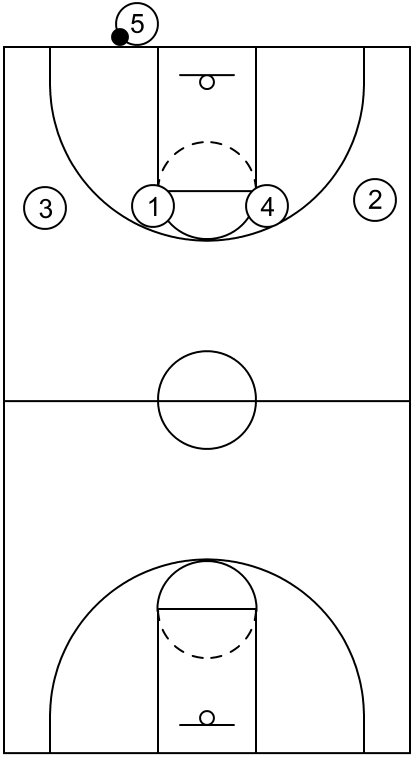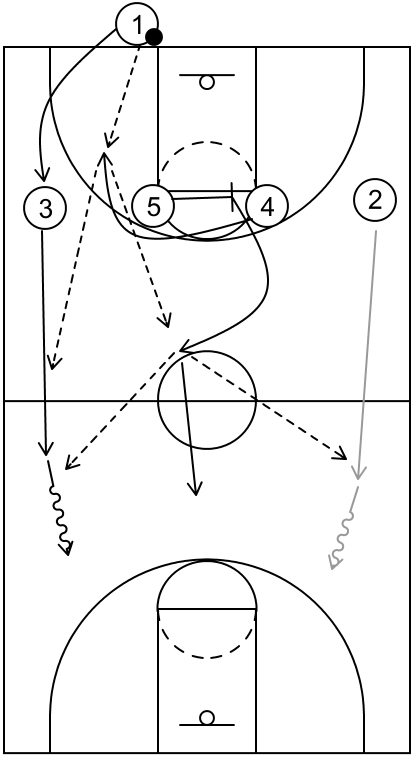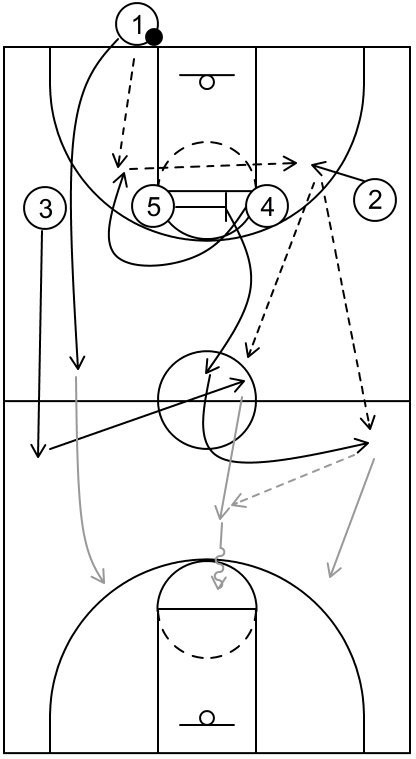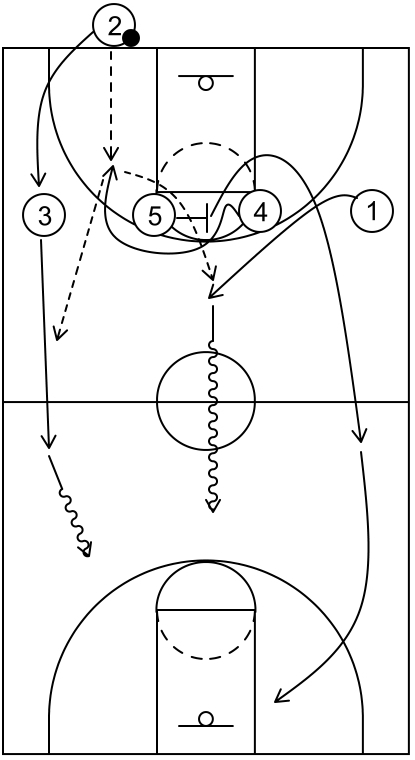What is the 1-4 press break
The 1-4 press break, also known as the 4-across press break, is a basketball offensive strategy that can be used as a counter against press defenses such as the 1-2-1-1 diamond press, the 2-2-1 press, the 1-2-2 press or a full court man to man press.
What are advantages of the 1-4 press break
One notable advantage of the 1-4 press break is that it features two offensive players on each side of the floor, which in turn, automatically creates an overload condition.
Therefore, at least one of the press defenders will probably not be able to cover at least one of the offensive players efficiently and effectively.
When that occurs, at least one of the offensive players will most likely be able to get open and receive the ball. This, at minimum, could relieve some of the defensive pressure and at maximum, it could simply break the press.
What is an example of the initial formation for the 1-4 press break

This is an example of the initial formation for the 1-4 press break. As alluded to earlier, the primary reason this particular press break is also referred to as the 4-across press break is because there are four offensive players lined up across the free throw line extended areas that include the wings and high posts.
It also features one offensive player that will execute the inbound pass. For this specific example, 2 and 3 start near the wings while 1 and 4 start near the high post elbow areas. Also, 5 will inbound the ball near the baseline.
What are examples of the 1-4 press break
These are diagram examples of the 1-4 press break that could potentially generate one or more scoring opportunities against various full court press defenses.
Additionally, standard basketball positions are utilized as it relates to numbers for the players within the diagrams.
Basically, player 1 is the point guard, player 2 is the shooting guard, player 3 is the small forward, player 4 is the power forward, and player 5 is the center.
Example 1

This is an example of a 1-4 press break that could be useful against the 1-2-1-1 press or the 2-2-1 press. To begin, 4 receives the ball from 5.
Next, 2 cuts to the ball side as the first option and could receive the basketball from 4. If the first option is not available, then 1 cuts to the middle of the court as the second option.
At the same time, 3 sprints to the opposite sideline. From this point, if the offensive team executes quick passes into the frontcourt, then a numbers advantage could occur against the press defense.
Example 2A

This is an example of a 1-4 press break that could be used against a full court man to man defense. To start, 4 cuts to the ball via a cross screen set by 5.
Afterwards, 4 receives the ball while 5 cuts down the middle of the court. As that happens, 3 cuts down the strong side wing into the frontcourt.
Also, at the same time, 2 stays within the backcourt for the time being. Next, 5 could receive the ball from 4 as the first option or 3 could receive the ball instead as the second option.
If 5 receives the ball from 4, then 2 could cut down the weak side wing area, shown with the gray arrow.
Following that, 2 could receive the ball from 5 and dribble to score at the rim or take a jump shot if open. Also, as an alternative option, 3 could receive the ball from 5 and score at the rim or take a jump shot if open.
Example 2B

This is an example of the previous 1-4-press break setup with a few differences. As before, 3 cuts down the ball side wing while 5 cuts down the middle after setting the cross screen.
However, this time, 3 and 5 are not open as the first and second passing options once 4 receives the ball.
When that happens, 4 executes a fake pass to either 3 or 5 and afterwards, 2 could receive the ball from 4 via a skip pass to the other side of the floor.
Following that, 5 cuts to the ball side wing while 3 fills the middle that was just vacated by 5. Also, 1 cuts down the court on the weak side wing.
Next, 3 could receive the ball from 2 and if that occurs, then that would effectively break the press.
Alternatively, 5 could receive the ball from 3 as a secondary option and if that occurs, then 3 could cut down the middle of the court and receive the ball again from 5.
From that point, 3 could dribble towards the basket with 1 and 5 cutting down the wings as a potential numbers advantage against the defense, shown with gray arrows on the diagram.
Example 3

This is an example of the 1-4 press break that seeks to quickly create a numbers advantage for the offense. To start, 4 cuts to the ball via a cross screen set by 5. As that happens, 3 begins cutting down the strong wing.
Also, 5 begins to cut down the court on the weak wing and at the same time, 1 cuts to the middle of the court. From that point, 1 could receive the ball from 4 as the first option.
If that occurs, then 1 could dribble towards the basket with 3 and 5 as passing options on the wings for a possible numbers advantage against the defense.
Conversely, if 1 is not open, then 3 could receive the ball from 4 as the second option. From there, 3 could dribble towards the basket, take an open jump shot, or utilize 1 or 5 as potential passing options.
Affiliate Disclosure: I may earn a commission on qualifying purchases made through the links below.
Example 4

This is an example of a 1-4 press break that could be executed at the end of a period such as during the last five to seven seconds of a quarter when the team needs to score at least two points or possibly three-points to tie or win the game.
It is derived from 25 Full-Court, Late-Clock Situation Plays by Austin McBeth.
This action could be most effective when the defense is executing a full court man-to-man defense and/or when the defensive pressure is very aggressive in the backcourt with no safety defender to strongly protect the basket within the frontcourt.
To begin, 2 should initially fake a cut towards the basket before sprinting back to the basketball. Additionally, as that occurs, 1 should cut towards the ball via double screens set by 3 and 5.
Immediately after 1 cuts to the ball following the second screen, 3 should quickly break out towards the basket and look to receive the ball via a long-distance air pass such as a baseball pass executed by 4.
It should also be mentioned that 4 should time the pass so that the ball is already in the air as 1 is cutting towards the ball immediately after the second screen.
If the team needs two points, then 3 could attack the rim and score via a layup or 3 could stop and pop for a mid-range jump shot.
Furthermore, if 5 possesses an above average amount of speed, then 5 could run to the rim following the first screen, receive the ball from 3, and score via a layup or dunk.
Conversely, if the team needs three-points, then 3 could stop and pop for a three-point field goal attempt or alternatively, 2 could sprint into the frontcourt near the wing, receive the ball via a kick pass from 3, and then take a three-point jump shot.